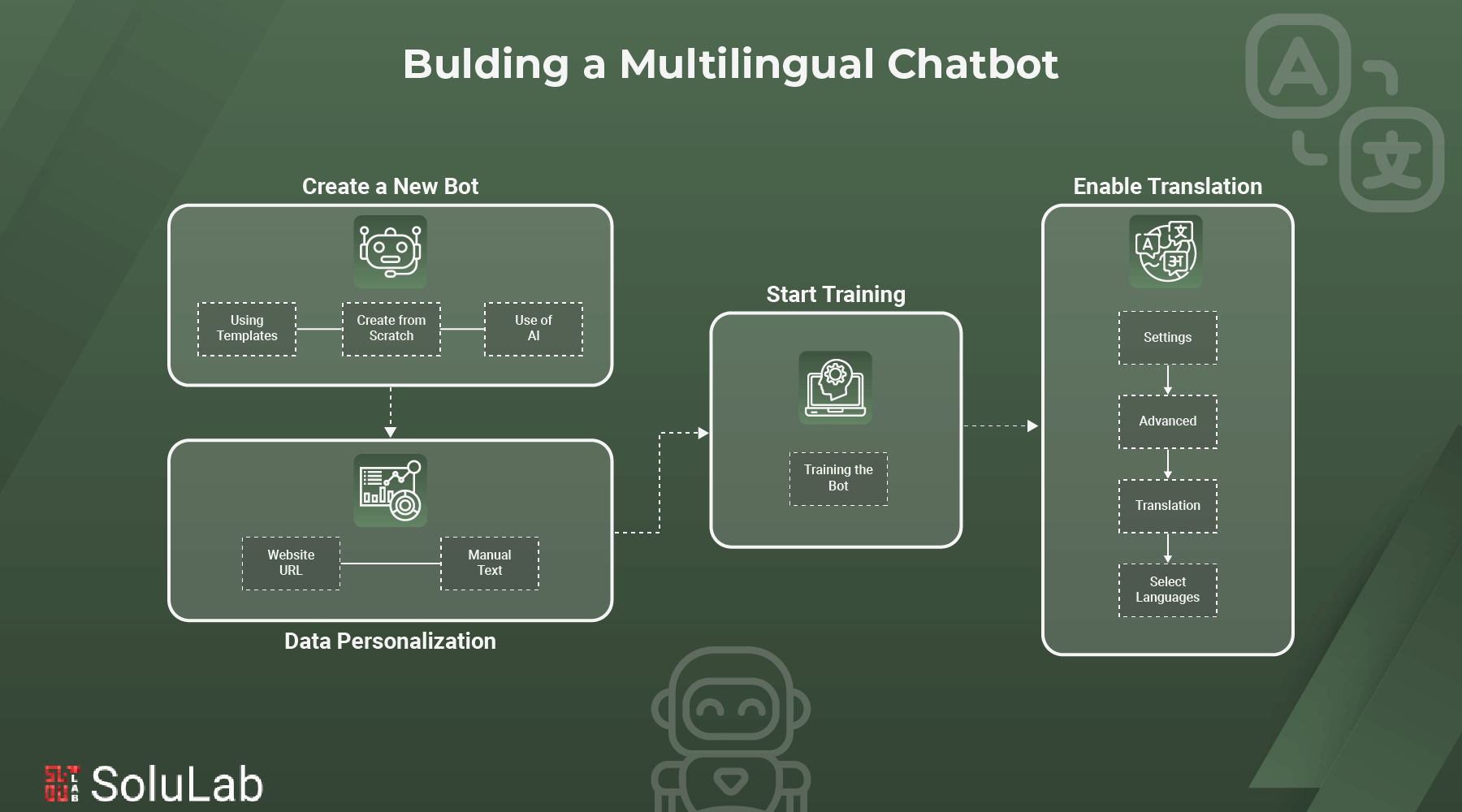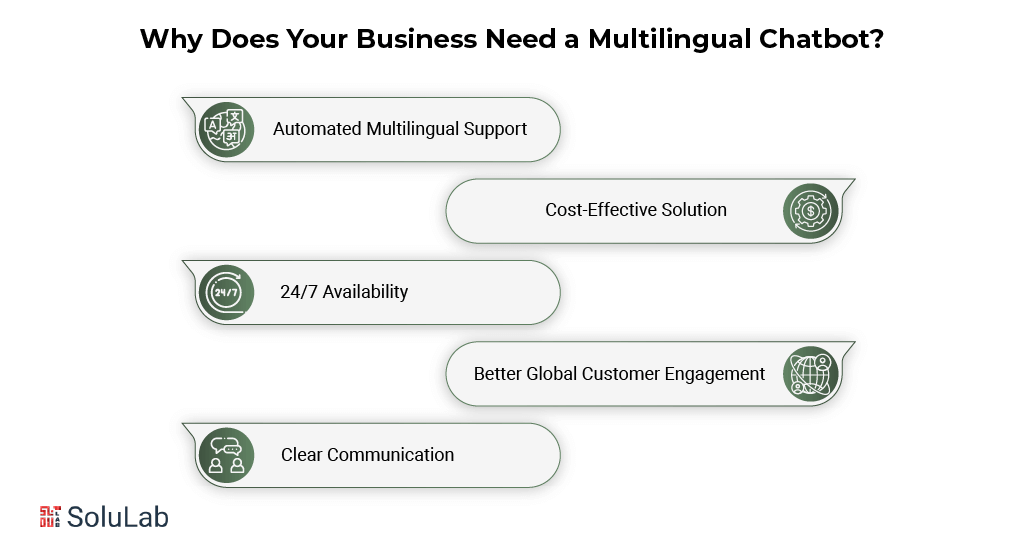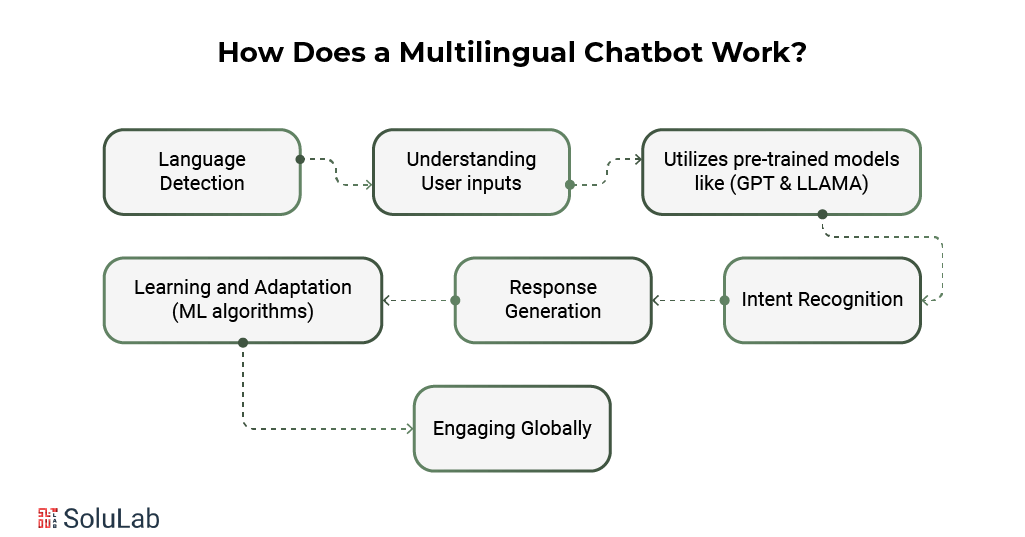
Language barriers can slow down business progress. Whether you’re a customer support manager assisting non-native speakers or an e-commerce business owner losing sales because of communication issues, it’s a challenge we all face. Hiring multilingual staff? That can get pricey. Ensuring consistent service across multiple languages? That’s no easy feat. Enter multilingual chatbots—your go-to solution for connecting with customers around the world.
Research shows that 76% of online shoppers prefer buying from websites in their language, even if the language options are limited, and 40% will avoid purchasing from a site that isn’t in their language.
The global chatbot market is projected to grow from $7.01 billion in 2024 to $20.81 billion by 2029, highlighting the increasing adoption of AI-powered chatbots.
82% of customers prefer chatbots over waiting for a representative, a 20% rise since 2022, indicating a strong demand for instant, multilingual support.
In this blog, we’ll explore how multilingual chatbots work, share tips for setting them up, and look at real-life examples to highlight their power.
What is a Multilingual Chatbot?
Multilingual chatbots can converse with people in multiple languages. They automatically recognize and respond in a user’s preferred language, improving interaction. It serves a global, multilingual user base through communicating with them in their preferred languages using NLP and translation.
A multilingual chatbot can easily switch between languages based on the customer’s preferences. It allows customers to interact in their native language, making the support process smoother. The chatbot can either detect the language automatically through the customer’s browser or let them pick the language they’re most comfortable with.
For businesses with a global presence, a multilingual chatbot is a must-have for offering self-service support. It doesn’t just translate words; it adapts to the customer’s culture and location. This is where true localization comes in.
What’s more, multilingual crypto trading bots can handle multiple customers at once, freeing up your human agents to focus on those who truly need personalized assistance.
Why Does Your Business Need a Multilingual Chatbot?

Your company needs a gen AI in customer service like a multilingual chatbot to solve language barriers. It could be the perfect solution to your localization challenges. AI-powered chatbots perform better—here’s why your firm should consider one:
1. Automated Multilingual Support
Does your firm handle daily inquiries in multiple languages? A multilingual chatbot lets you serve every customer in their preferred language—without needing a large agent workforce.
Supporting English, Spanish, French, and even regional languages, it ensures smooth communication with prompt and accurate responses. While customers enjoy faster service, your team can focus on more strategic tasks.
2. Cost-Effective Solution
Hiring and training multilingual staff is expensive and often unsustainable as your business grows. A multilingual chatbot automates support across languages, saving costs without compromising service quality—a critical factor in building customer trust.
3. 24/7 Availability
Customers need support beyond office hours. A multilingual chatbot works round the clock, assisting users in Tokyo at 3 a.m. or New York at 5 p.m. This always-on availability enhances customer satisfaction and shows you value their convenience.
4. Better Global Customer Engagement
Language barriers limit audience reach. A multilingual chatbot helps you connect with customers worldwide, making them feel valued when addressed in their native language. This boosts engagement, conversions, and overall satisfaction.
5. Clear Communication
Human agents, even fluent ones, can struggle to provide consistent support across languages, leading to misinterpretations.
Multilingual chatbots eliminate guesswork. They deliver accurate and consistent responses in any language, ensuring clear communication every time.
Can Chatbots be multilingual?
Yes, chatbots can be multilingual! There are different ways to create one, but before, let’s break down what a multilingual chatbot is.
In simple terms, a multilingual chatbot is a virtual assistant that can understand and respond to customer queries in several languages. It detects the language of the customer, finds the relevant response from its database, and replies in the same language. It can even handle multiple customers at once, all in their preferred languages.
Now, let’s look at the three common methods for building a multilingual chatbot:
- Train one chatbot to understand and respond in multiple languages by feeding it training data in various languages.
- Create a separate chatbot for each language.
- Build a crypto arbitrage chatbot in one language that can communicate in many languages.
Of these three methods, the AI-driven approach is the most effective. Using Natural Language Processing (NLP), the chatbot can detect the language, analyze the text, and generate accurate, contextually appropriate translations and responses. You only need to train the bot in one language (like English), and machine translation allows it to communicate seamlessly in multiple languages.
How to Build a Multilingual Chatbot?
By offering multilingual service, a multilingual bot can improve user experience. Here is a basic, step-by-step tutorial to help you get going:
Step 1: Log in to your dashboard’s Bots section. To build a chatbot, you will have three possibilities.
- Make Using Templates
- Create from Scratch
- Use of AI
Now, select “Using AI” from the available dropdown menu after clicking the “+Create New Bot” button. Provide the information your bot needs to learn and communicate with users.
Step 2: Use data to personalize your bot
There are two ways you can set up your bot:
URL: In the “Website URL” area, type the URL of your website. This enables the system to collect information from your website through crawling, which helps to add your unique content—such as product descriptions and frequently asked questions—to the bot’s knowledge base.
Text: You can manually enter text if you would rather not utilize your website or if you would like to add more information. This option is excellent for giving precise guidelines, rules, or any other information you wish to make sure your bot is aware of and capable of conveying to consumers.
Click “Process Data” to proceed after selecting your desired source of data method and entering the necessary data. If you click the edit icon, you can also change the processed data.
Step 3: Click “Start Training” once the website data has been correctly processed.
Step 4: To enable real-time translation, click on “Settings,” click “Advanced,” choose “Translating,” and turn on the current translation box. You can now select the translation language of your choice.
Now, pick the language you prefer from the list of alternatives by clicking on the “globe icon” at the bottom of the chat screen.
Your multilingual bot is now built and ready to use.
Benefits of Multilingual Chatbot
Seventy-four percent of customers use chatbots for simple questions. For businesses with a global clientele, multilingual chatbots are essential. However, it’s important to understand the pros and cons of multilingual chatbots.
1. Better Customer Reach:
A multilingual chatbot increases conversion rates by responding in consumers’ preferred languages. This helps guide purchase decisions and boosts conversions. Customers will perceive businesses as more approachable and reliable, offering a competitive edge. This, in turn, enhances customer loyalty and brand preference.
2. Cost-Efficiency:
A multilingual chatbot automates support operations, reducing manual workloads and saving money.
3. Scalability:
It makes scaling customer support easier as the business grows in customers and regions. Offering support in customers’ local languages also improves the overall customer experience.
Localized content boosts client engagement, with 75% of customers stating that it makes them more likely to interact with a brand. Personalized support fosters contentment and trust, improving customer satisfaction.
4. Improved Customer Support:
Eighty-eight percent of customers believe excellent service leads to more purchases. A multilingual chatbot provides 24/7 personalized care, helping to retain customers.
By using multilingual chatbots, businesses can expand globally, reach more customers, and overcome language barriers.
How Does a Multilingual Chatbot Work?

A multilingual chatbot uses AI technology, such as Natural Language Processing (NLP) and Machine Learning (ML), to communicate effortlessly in different languages.
- Language Detection: It starts by detecting the user’s language using NLP algorithms, which analyze linguistic patterns through methods like probabilistic models, n-grams, or neural embeddings. These techniques help the bot tell apart languages that are closely related, such as Spanish and Italian, by recognizing subtle context and word structure differences.
- Understanding User Inputs: Once the chatbot identifies the language, it adjusts its responses to create a personalized experience.
- Utilizes Pre-trained Models: Advanced models like GPT (Generative Pre-trained Transformer) ensure the conversation flows naturally by understanding the context.
- Learning and Adaption(ML Algorithm): open-source models like LLAMA allow businesses to tweak the bot using their data, keeping it in line with data privacy and security guidelines.
- Response Generation: When it comes to translation, tools like Google Translate or Microsoft Translator use neural machine translation (NMT) to provide real-time translations that are contextually accurate.
- Intent Recognition: The system also relies on a centralized intent recognition framework to standardize inputs across languages, mapping them to specific intents using vector embeddings. This helps deliver consistent, localized responses and execute workflows smoothly.
- Engaging Globally: ML algorithms improve over time by incorporating feedback loops. These algorithms adapt to things like slang, cultural nuances, and individual preferences, ensuring the chatbot keeps up with users’ needs. Ultimately, this makes the chatbot an indispensable tool for AI development companies aiming to connect with a global, diverse audience.
Challenges of Building a Multilingual Chatbot
Dealing with language differences and cultural nuances can be challenging. However, with the right strategies, these obstacles are manageable. Let’s explore some best practices to make implementing a multilingual chatbot smoother and more effective.
1. Handling Linguistic Variations and Idioms
Different languages have unique idioms and cultural references that might not translate directly. Capturing these nuances accurately can be difficult.
Best Practices:
- Contextual Understanding: Invest in NLP models that focus on contextual understanding to interpret idiomatic expressions across languages.
- Localization Teams: Work with linguists or localization experts to ensure accurate translations that maintain cultural context.
2. Ensuring Accuracy and Quality
Maintaining translation accuracy while preserving the original intent across languages is a significant challenge.
Best Practices:
- Human Review: Incorporate a review process with bilingual experts to validate translations for accuracy, tone, and cultural sensitivity.
- Continuous Improvement: Implement feedback loops and regular updates to refine translations based on user interactions and linguistic data.
3. Scalability and Maintenance
As the number of supported languages grows, maintaining consistency and scalability becomes more complex.
Best Practices:
- Automated Workflows: Automate the process of creating language versions in the chatbot. With automation, simply select a language and publish it instantly.
- Modular Design: Create a modular architecture that allows for easy scalability and updates across all language variants.
4. User Experience
Providing a seamless and uniform user experience across languages can be challenging due to linguistic differences.
Best Practices:
- Multilingual User Testing: Conduct extensive user testing with native speakers of each supported language to ensure usability and cultural appropriateness.
- Adaptive Design: Design the chatbot interface to dynamically adapt to linguistic variations without compromising user experience.
5. Continuous Monitoring and Improvement
Chatbots require continuous monitoring and optimization to stay relevant and effective across multiple languages.
Best Practices:
- Analytics and Insights: Use tools to analyze user interactions in different languages. For example, REVE Chatbot offers language-based insights and analytics, helping identify areas for improvement and making informed updates.
- Agile Approach: Use an iterative approach to implement changes and enhancements based on user feedback and evolving linguistic trends.
Best Practices for Multilingual Chatbot
Now that you’ve learned how to create a multilingual chatbot, let’s quickly highlight some effective best practices for multilingual chatbots:
1. Continuous Training: Regularly update the training content of your multilingual chatbot. This includes both refreshing existing content and adding new material when necessary.
2. Monitor Performance: Keep track of the bot’s performance through customer feedback and analytics to ensure it’s meeting expectations.
3. Refine Responses: Have human agents review and refine the chatbot’s responses. Ideally, use native speakers for this task to ensure accuracy.
4. Compliance: Make sure the chatbot complies with regulations in all the regions where it operates.
Building a multilingual chatbot is one step, but ensuring it provides accurate responsible AI is equally important. Businesses should invest the right time and resources to optimize the bot’s performance.
How Do Companies Benefit from Using Multilingual Chatbots?

Multilingual chatbots are a game-changer, giving businesses the ability to connect with a much wider audience and offer a smooth, personalized experience in different languages.
Let’s break down the key benefits that come with implementing multilingual chatbots:
- Broader Customer Reach – With multi-language support, businesses can engage non-English-speaking customers, significantly broadening their market. In fact, about 60% of shoppers avoid sites that only offer English.
- Improved Customer Experience – When customers get help in their language, it feels more personal and natural. This leads to happier clients and stronger loyalty. According to Deepl’s report, 75% of people say localized content boosts engagement.
- Higher Conversion Rates – Customers are more likely to buy when they can interact in their preferred language. REVIEWS.io saw a 120% increase in traffic and a 20% jump in conversions after they translated their site into German.
- Around-the-Clock, Global Support – Research shows that 51% of customers expect businesses to be available 24/7. Multilingual chatbots can offer continuous support in multiple languages, so customers across different time zones always have access to help, even outside regular business hours.
By tapping into the potential of multilingual chatbots, businesses can build stronger relationships with customers worldwide, driving growth and success on the global stage.
Real-World Examples of Multilingual Chatbot
A multilingual chatbot can truly set a company apart from those that don’t use one. Let’s explore a few businesses that are successfully leveraging multilingual chatbots to enhance their operations.
Veritas Finance Limited is working to provide financial support to micro, small, and medium enterprises (MSMEs) in India, a group that has long been underserved. The company’s primary goal is to make credit more accessible, particularly in rural areas.
The main challenge they faced was reaching people in their native language, as many rural individuals were not proficient in English. The solution came in the form of the REVE multilingual chatbot development, which was implemented in seven languages: Hindi, Bengali, English, Kannada, Tamil, Telugu, and more. Since adopting the chatbot, Veritas has seen a 40% increase in customer interactions, reaching previously inaccessible populations.
Another example is the Mexican Government institution INAI, which stands for Instituto Nacional de Transparencia, Acceso a la Información y Protección de Datos Personales (National Institute for Transparency, Access to Information, and Protection of Personal Data). INAI is responsible for ensuring transparency, public access to government information, and personal data protection in Mexico. It handles information requests, enforces privacy regulations, and promotes accountability to strengthen open governance and citizens’ rights.
To serve its citizens, INAI uses REVE’s multilingual chatbot in both English and Spanish, covering all of Mexico’s population. By using this tool, INAI has expanded its reach to both Spanish and English-speaking citizens, which would have otherwise been impossible. Additionally, customer satisfaction has improved by 45%.
Conclusion
The increasing need for instant service in customers’ preferred languages highlights a key reality: businesses can’t afford to ignore the powerful role multilingual chatbots play in offering personalized, inclusive, and global customer experiences.
AI and language models like GPT and LLAMA, multilingual chatbots combine natural language understanding with real-time translation. This helps break down language and cultural barriers effortlessly. These AI tools don’t just improve customer support by offering 24/7 multilingual assistance, they also help businesses connect with diverse audiences on a larger scale, fostering stronger relationships and driving engagement.
SoluLab helped Sight Machine, a leading AI-based company in digital manufacturing, by providing expertise in generative AI and machine learning to overcome resource constraints. Sight Machine sought help to enhance its digital twin offerings, develop scalable architecture, and integrate advanced AI models. SoluLab’s support enabled them to deliver solutions and derive meaningful insights, accelerating their product development. SoluLab is an AI development company that has a team of experts to discuss your business problems and solve them. Contact us today.
FAQs
1. What is the future of multilingual chatbot technology?
The future of multilingual chatbot technology looks promising, with advancements in AI and NLP driving more accurate, personalized, and scalable solutions. This will allow businesses to better serve diverse global audiences with seamless communication.
2. Is LLM important for multilingual chatbots?
Yes, large language models (LLMPs) are crucial for multilingual chatbots as they enable real-time translation, nuanced understanding, and context-aware responses across different languages, enhancing user experience and interaction.
3. Do I need to build a chatbot in all languages?
No, it’s not necessary to cover every language. Focus on the languages most relevant to your target audience to maximize engagement and improve efficiency while keeping costs manageable.
4. What is multilingual NLP?
Multilingual NLP application refers to the ability of AI systems to understand, interpret, and generate text in multiple languages, allowing chatbots to communicate with users from diverse linguistic backgrounds.
5. What are the key steps to building a multilingual chatbot?
To build a multilingual chatbot, you’ll need to define your target languages, choose the right platform and AI model, integrate translation tools, ensure natural language processing (NLP) capabilities, and test for accuracy and consistency across languages.






